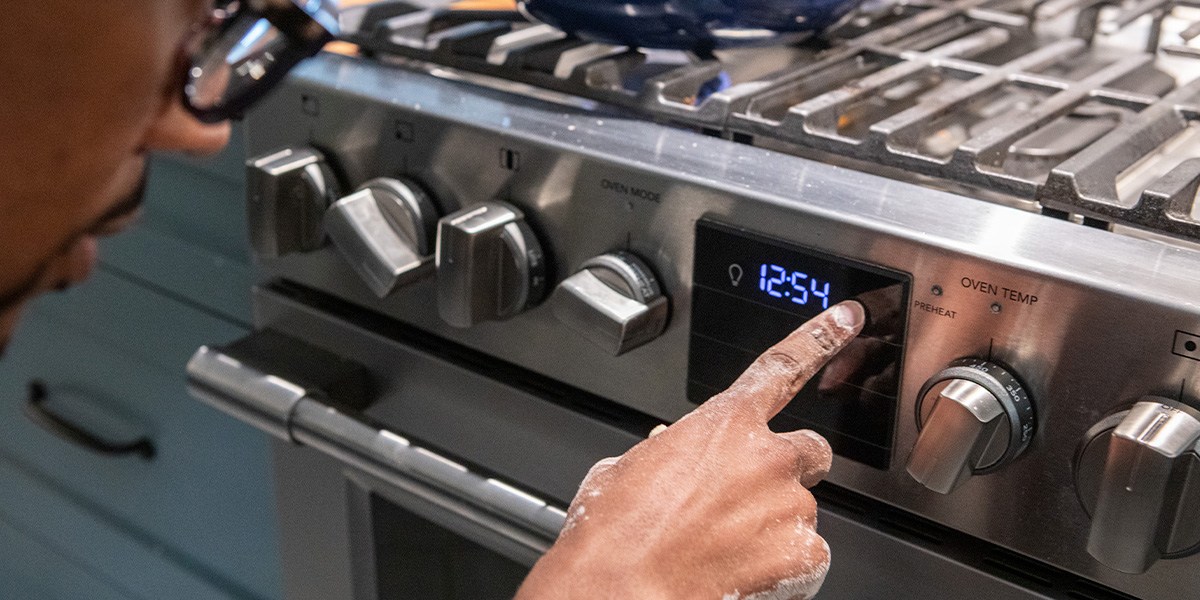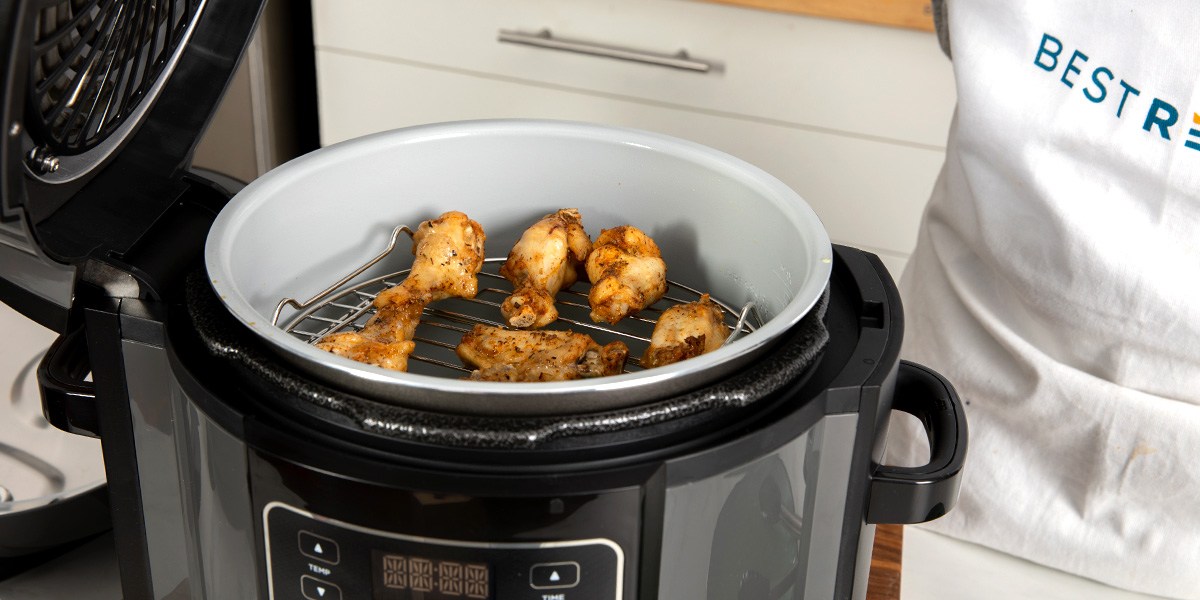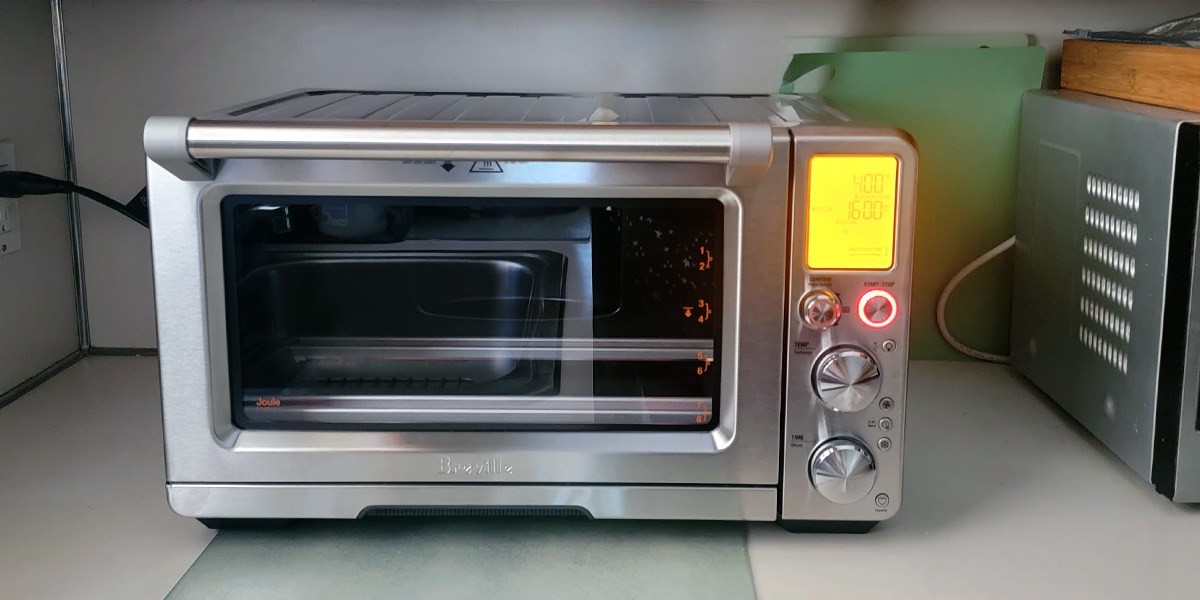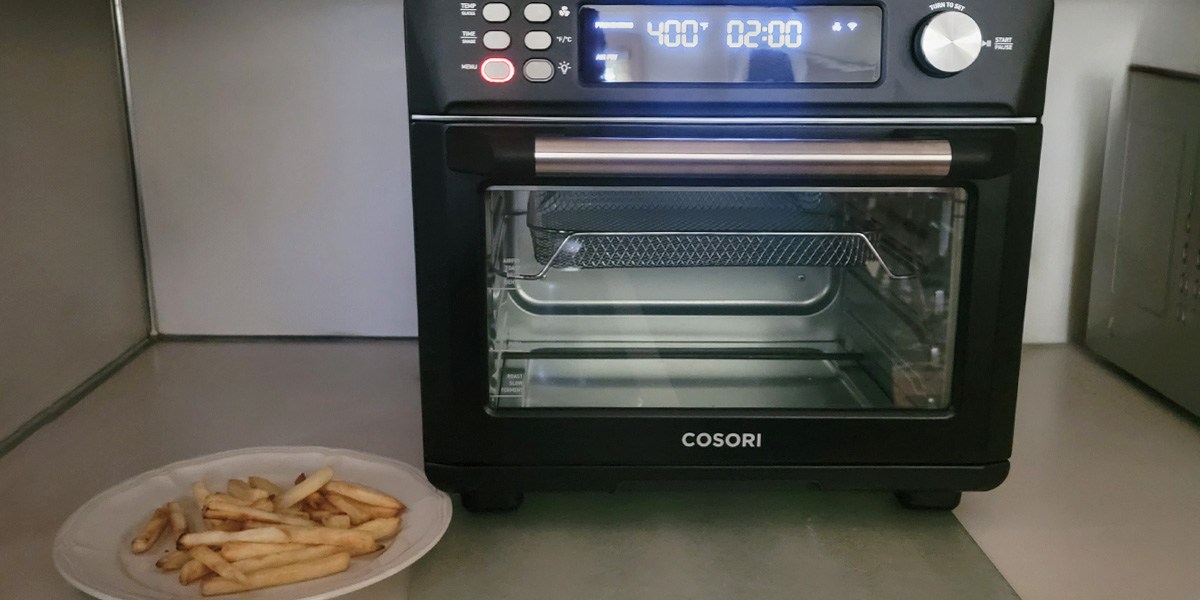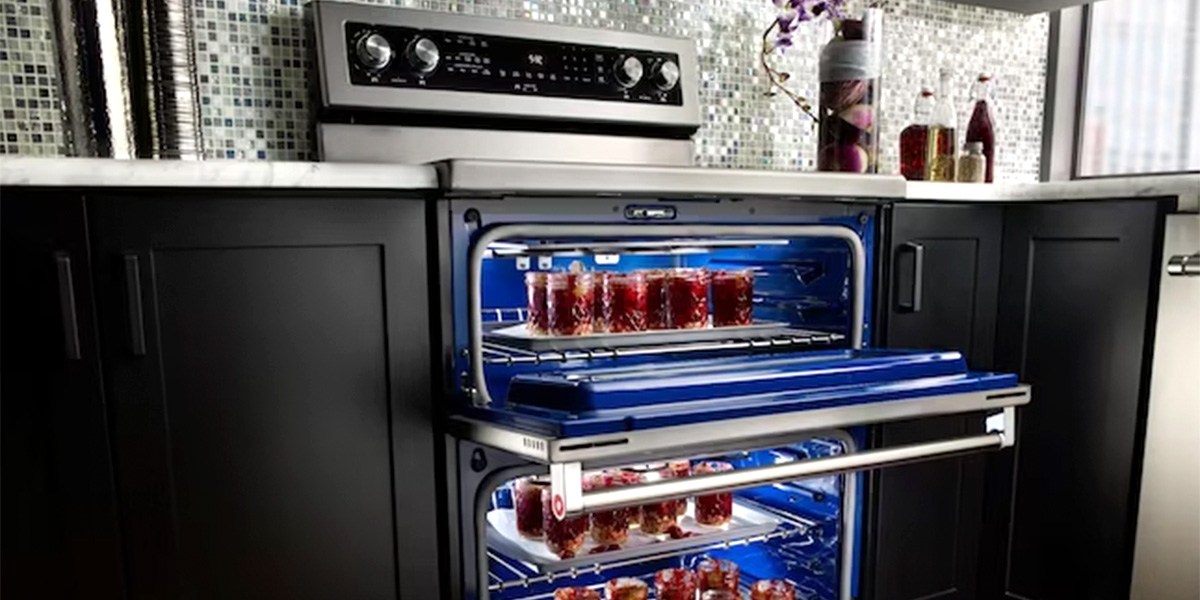How does baking stand up to air-frying?
Air fryers have become a popular addition to many home kitchens in recent years. But if you’ve been on the fence about jumping on the bandwagon, you’ve probably wondered how it compares to your conventional oven. Air fryers and ovens prepare foods similarly, but some key differences affect how quickly your meals are ready and how crispy your food turns out.
An air fryer allows you to enjoy your favorite traditionally fried foods like french fries and chicken tenders with little to no oil — and in much less time than when prepared in a traditional oven. Foods wind up crispy on the outside and juicy or tender on the inside. On the other hand, a conventional oven is much larger, so you can prepare meals for a big family gathering or party more easily. It can usually accommodate a wider range of recipes, too.
To help you decide whether an air fryer or an oven is best for your next meal, we took a deep dive into how air fryers and ovens compare. Once you understand the similarities, differences and pros and cons of each, you’ll know which recipes to rely on your oven for and which to bust out the air fryer for.
What is an oven?
You likely have plenty of experience using the conventional oven in your kitchen but may not understand exactly how it works.
The air inside your oven is heated with two heating elements that slowly cook the food. Because the air isn’t circulated around the foods, though, the racks’ placement inside an oven is key. The lower position places the food closer to the bottom heating element, which works well for cooking large pieces of meat. The top position helps brown the top of foods, while the middle position is usually the default for baking.
Most conventional ovens measure between 27 and 30 inches wide, offering a capacity between 2 and 6 cubic feet. For one to three people, 3 cubic feet is usually sufficient. For larger families or frequent entertaining, though, you’ll do better with at least 5 cubic feet.
In some cases, such as frozen pizza, you can place the food directly on the rack, but an oven usually requires cookware to hold the food while it cooks. Cookie sheets, casserole dishes, Dutch ovens and baking pans are used for many recipes.
Baking is the most common cooking method used in an oven. It uses moderate temperatures between 250 and 400 degrees, but most baking recipes call for 350 or 375 degrees. The baking process heats foods more slowly and ensures that they’re cooked all the way through. Popular foods for baking include cookies, cakes, bread and casseroles.
You can also roast foods like whole chickens, turkeys, beef roasts and other cuts of meat in your oven, as well as potatoes and other veggies, but roasting requires cooking them at higher temperatures of 400 to 500 degrees. Broiling is another option for oven cooking. You place the food in the upper-rack position directly beneath the top heating element at high temperatures of 500 to 550 degrees to brown dishes like casseroles and pizza and finish them off or quickly cook thin cuts of meat and delicate veggies.
Oven advantages
- Capacity: A standard oven offers a large capacity that can easily handle group cooking and regular entertaining for holidays and other occasions. It also allows you to prepare several dishes at once. The average capacity for a conventional oven is 3 cubic feet, but the biggest models are as large as 6 cubic feet. That’s approximately three to six times larger than the greatest capacity air fryers.
- Maximum temperature: Most standard ovens have a maximum temperature of 550 degrees. That’s 100 to 150 degrees hotter than the maximum temperature on most air fryers, which increases the number of recipes you can prepare.
- No additional expense: Nearly all homes and apartments come with a conventional oven in the kitchen when you purchase or rent. That means you usually don’t need to spend any additional money on another appliance.
Oven drawbacks
- Cooking time: While a standard oven’s larger capacity allows for larger quantities of food, it also extends its cooking time. In fact, cook times in a standard oven are typically 20% to 50% longer than those in an air fryer.
- Uneven cooking: Hot air doesn’t always circulate evenly in a standard oven. As a result, your food can wind up with a crispy or crunchy exterior but a dried-out interior.
- Heat production: A full-size conventional oven emits more heat than a countertop air fryer because it is larger, requires longer cook times and needs to preheat. In warm weather, your kitchen can get unpleasantly hot when cooking in a standard oven.
What is an air fryer?
Air fryers are countertop appliances that pair a heating element similar to those used in an oven with a fan. The fan circulates the air around the food to ensure that it cooks evenly. As a result, an air fryer can produce foods with a crispy exterior and a juicy or tender interior with little to no oil. The convection fan also allows an air fryer to significantly reduce cooking time by ensuring the food is surrounded by hot air.
Most air fryers are relatively compact, but you can find them in two styles: basket air fryers and air fryer ovens. Basket air fryers usually have an egg shape and feature a drawer with a basket inside that holds the food. Air fryer ovens resemble toaster ovens, so they are generally rectangular or square and have a removable basket you place inside the traditional wire cooking rack found in a toaster oven.
A basket air fryer is usually the most compact, so it offers the smallest capacity. Most basket-style models can hold between 1 and 10 quarts. For a family of four, a 3- to 5-quart can work well, but you’ll want a model with at least a 10-quart capacity for large groups or cooking a whole chicken. A basket-style model often only has an air-frying function, though you can still bake and roast in it because an air fryer is essentially just a mini convection oven.
On the other hand, air fryer ovens require more countertop space but also provide a larger capacity. They can usually hold between 12 and 30 quarts. Most air fryer ovens can fit a whole chicken, and some can even fit a small-to-medium turkey. They also offer additional cooking functions, such as toasting, baking, broiling, roasting and slow cooking. Some even have temperatures that go low enough for dehydrating, proofing dough and fermenting.
Because they’re more compact than a standard oven and have a convection fan to circulate air, you can reduce cooking temperatures and times in an air fryer. In most cases, you should lower the temperature by 25 to 50 degrees and cut the cooking time by 20%. For even cooking, you’ll also want to flip large food like chicken wings, chicken tenders or cuts of meat or shake smaller foods like french fries, onion rings or Brussels sprouts in the basket halfway through cooking.
While you don’t need oil when using an air fryer, a small amount can help foods get extra crispy. Before air-frying, mist or toss the food with olive oil, avocado oil, grapeseed oil or another oil with a high smoke point to help them crisp and brown better.
Air fryer advantages
- Cooking time: With a convection fan to circulate the hot air throughout its interior and a smaller overall area to heat, an air fryer can reduce your cooking time by up to 20%.
- Even cooking: Food also cooks more evenly in an air fryer because the hot air surrounds the food. That means you wind up with food that’s crispy on the outside but still tender and/or juicy on the inside.
- Compact design: Many air fryers — especially basket-style models — take up very little space on your counter, so they can fit any size kitchen. Most are also fairly lightweight, allowing you to store them in a cabinet and only take them out when necessary.
- Energy efficient: Air fryers are more energy efficient than a standard oven because they are smaller and have shorter cooking times. An air fryer can use up to 50% less energy than an oven.
- Less heat: Because air fryers are smaller and don’t need as much time to cook as a standard oven, they don’t emit as much heat. As a result, your kitchen won’t get noticeably hotter when you’re cooking, making them an excellent option for summer cooking.
- Healthier than deep-frying: If you love foods like french fries, chicken nuggets and onion rings, you know that the deep-fried versions aren’t the healthiest option. An air fryer lets you get foods nearly as crispy as deep-frying without submerging them in oil. In fact, you don’t necessarily have to use any oil when air-frying — though a light misting of a healthy oil, such as olive or avocado, will help foods crisp and brown better.
Air fryer drawbacks
- Capacity: Because of their compact design, the main drawback to an air fryer is its limited capacity. Even the largest air fryer ovens can’t hold as much food as a traditional oven, making it difficult to cook for large groups for holiday dinners and other parties.
- Maximum temperature: Many air fryers max out at 400 or 450 degrees, while a traditional oven typically reaches 500 to 550 degrees. Higher temperatures lead to more effective broiling.
- Additional expense: Unlike a standard oven, which usually comes as part of a kitchen in a home or apartment, you have to purchase an air fryer. Many are reasonably priced, but it’s still an added expense for your kitchen.
Air fryer vs. oven: Similarities
- Similar cooking functions: While an air fryer has a convection fan and an oven does not, they both use hot air to cook foods. That means you can bake, roast, toast, warm and reheat in both. Air-frying is essentially just baking in a convection oven.
- Don’t need oil: When baking in an oven or air-frying in an air fryer, you don’t need to add as much oil to your food as you would when deep-frying or pan-frying foods. You can use a small amount to help foods crisp and brown better, but cooking in an oven or air fryer is healthier than frying.
Differences between an air fryer and an oven
The obvious difference between an air fryer and an oven is their size. A standard oven is a large appliance that can easily prepare food for groups and special occasions. On the other hand, an air fryer is a compact countertop appliance suited for everyday cooking for smaller groups.
But an air fryer’s smaller size means it uses less energy than an oven, reducing energy costs and keeping your kitchen cooler than baking in an oven. The size, paired with the convection fan that circulates the air inside an air fryer, also significantly reduces cooking time, so you can get your meals on the table more quickly.
Additionally, an air fryer usually provides more even cooking results than an oven because of the circulated air. In particular, an air fryer does a better job crisping or browning the exterior of foods while keeping the inside juicy and tender. In an oven, foods that get crisp on the outside often dry out inside, which can be a big problem when cooking meat.
Gas oven vs. electric oven
Standard ovens are available with two energy sources: gas and electric.
A gas oven generally provides instant control over the heat and preheats more quickly than an electric model. It also creates a moist cooking environment, so it’s less likely to dry out food. On the other hand, electric ovens are easier to clean and often broil more effectively.
Additionally, gas stoves are more energy-efficient than electric models, so they can help you save on energy costs. However, they are more expensive initially and can even have additional installation costs if you need to set up a gas hook-up. Gas stoves also raise environmental concerns because they can release carbon monoxide and other pollutants that pose a health risk. A gas stove can also develop a leak, so electric stoves are usually considered safer.
When to use an air fryer vs. an oven
You can cook most foods in both an air fryer and an oven, but some dishes turn out better in one appliance than the other.
Foods that should have a crispy exterior, such as french fries, chicken tender, chicken nuggets, onion rings, mozzarella sticks and even bacon turn out a little better — and quicker — in an air fryer. Single-serving meals are also easier to prepare in an air fryer.
However, an oven is a better bet if you’re cooking for a group. Larger foods like roasts, turkeys and full-size pizzas are also easier to prepare in an oven. You’ll want to save your favorite baked goods like cakes, muffins and brownies for the oven, too.
Which is healthier?
Air-frying and oven-baking are both fairly healthy cooking methods. That’s because neither requires much fat or oil.
However, an air fryer’s design allows the grease from foods like bacon and chicken wings to drip through the basket, so they don’t sit in the drippings as they cook. That can make them a little healthier. However, you can set foods on a baking rack on your sheet pan when baking in the oven and eliminate that issue.
Top air fryer models
Our favorite air fryers are large-capacity models with more cooking functions than just air-frying. Their versatility makes both air fryers highly useful kitchen appliances.
Breville the Joule Oven Air Fryer Pro
Product specifications
Type: Oven air fryer | Capacity: 1 cu. ft. | Dimensions: 17.3” L x 21.5” W x 12.8” H | Weight: 22.8 lb | Material: Stainless steel | Control Type: Knob | Number of Functions: 13 | Temperature Range: 80 to 480 degrees
The Breville Joule Oven Air Fryer Pro is an oven air fryer with a large capacity, so it can hold nine slices of toast, a 13-inch pizza, a 12-cup muffin tray, a nine-by-13-inch baking pan or a 14-pound turkey. During testing, we fit an entire two-pound bag of frozen french fries in the oven’s air-fryer basket with some room to spare, making it large enough to accommodate a large family or groups for entertaining. The Joule was also highly efficient, taking just 13 minutes to air-fry frozen french fries, 18 minutes for chicken wings and nine minutes for crisp bacon.
With 13 cooking functions, it’s also highly versatile. In addition to air-frying, it effectively toasted bread, baked cookies and reheated leftovers during testing and can roast, broil, slow cook, keep warm, proof dough and dehydrate. It has settings for bagels, pizza and cookies, too. The Joule is even Wi-Fi-enabled. That provides access to the Breville+ app, which offers hundreds of recipes and an Autopilot feature that walks you through the recipes and automatically switches the oven between cooking modes.
Cosori Smart Air Fryer Toaster Oven
Product specifications
Type: Oven air fryer | Capacity: 26 qt | Dimensions: 16.3” L x 16.9” W x 15.5” H | Weight: 22 lb | Material: Stainless Steel | Control Type: Button, knob and app | Number of Functions: 12 | Temperature Range: 80 to 450 degrees
The Cosori Smart Air Fryer Oven offers many of the same features as high-end air fryer ovens but at a much more affordable price. It isn’t as large as the Breville Joule, but it can hold four slices of toast, a 12-inch pizza or a 5-pound chicken. Our testing also revealed that it could hold 2 pounds of frozen french fries, so it can easily feed a family of five or more. It was highly efficient, too, needing just 12 minutes to air-fry french fries, 18 minutes for chicken wings and 10 minutes for bacon.
With functions and presets for air-frying, baking, toasting, roasting, broiling, warming, dehydrating, pizza, slow cooking, defrosting and fermenting, the Cosori offers plenty of versatility and can replace appliances like an air fryer, toaster oven, dehydrator and/or slow cooker. Like the Breville Joule, it is Wi-Fi-enabled and has a connected app that provides recipes to inspire your cooking. However, the Cosori’s VeSync app also allows you to control all the oven’s settings, so you can operate it even when you’re not in the same room.
Top oven models
Our favorite ovens are large enough to accommodate any holiday dinner or family gathering with room to spare. They’re both easy to clean, making maintenance less stressful, too.
Samsung Freestanding Electric Range with Wi-Fi and Steam Clean
Product specifications
Type: Electric | Capacity: 6.3 cu. ft. | Dimensions: 29 15/16” W x 46 5/16-47 1/16” H (adjustable) x 28 11/16” D | Material: Stainless steel and ceramic glass | Temperature Range:175 to 500 degrees | Wattage: 3,300 watts | Weight: 131 lb | Automatic Shutoff: Yes, with Timed Cooking
The Samsung Freestanding Electric Range is a large-capacity oven that can easily fit oversized casserole dishes and roasting pans to prepare multiple dishes for holiday dinners and other gatherings. In addition to basic oven functions like baking and broiling, the oven has Keep Warm and Bread Proof settings that make it more versatile. It also offers seven positions for its two racks to help you control how close your food is to the heat.
The oven is Wi-Fi-enabled, too, so you can use the connected app to preheat, adjust the cooking time and temperature and monitor your food’s progress via your smartphone. It’s also compatible with voice commands through Amazon Alexa, Samsung Bixby or Google Assistant. Cleaning the Samsung Freestanding Electric Range is also easy because it has a Steam Clean feature that can remove cooked-on food in just 20 minutes. There is even a storage drawer beneath the oven to hold bakeware and other cooking accessories.
KitchenAid Self-Cleaning Freestanding Double Oven Electric Convection Range
Product specifications
Type: Electric | Capacity: 6.7 cu. ft. (Oven 1: 4.2 cu. ft.; Oven 2: 2.5 cu. ft.) | Dimensions: 29 15/16” W x 47 3/8” H x 28 1/2” D | Material: Stainless steel and ceramic glass | Temperature Range:150 to 500 degrees | Wattage: 3,600 watts | Weight: 204 lb | Automatic Shutoff: Yes, with Timed Cooking
The KitchenAid Self-Cleaning Freestanding Double Electric Range has two ovens: a 4.2-cubic-foot oven and a 2.5-cubic-foot oven. They provide an extra-large combined capacity that not only lets you prepare large quantities of food but multiple dishes simultaneously, even if they don’t cook at the same temperature. The oven is easy to use because it has touch-activated electronic controls that allow you to precisely set the temperature and easy-glide racks that move food in and out effortlessly.
In addition to baking and broiling, the oven has slow cooking and dough-proofing functions, as well as a convection setting. Using the convection setting, you can get similar results to those in an air fryer. It even boasts an easy conversion system for convection cooking that takes the guesswork out of adjusting the temperature to ensure the best results. This KitchenAid oven also has a self-cleaning setting that makes cleaning up after cooking as easy as can be.
How we analyzed
To compare the performance of an air fryer and a standard oven, we prepared the same foods in both appliances.
We made frozen french fries, chicken wings, hot dogs, Brussels sprouts and bacon in a basket air fryer, an oven air fryer and a standard oven and evaluated the crispiness and taste of the finished foods. We also compared cooking times and how hot the kitchen got when each appliance was used.
Final thoughts: Which is best for you?
When it comes to an air fryer and a standard oven, it really isn’t an either-or situation. Nearly all homes and apartments have a standard oven, and you’ll need it for holiday dinners, dinner parties or other occasions when cooking for a large group.
However, for many people, an air fryer is still an excellent addition to the kitchen. It is ideal for homes with children because it can quickly make crispy chicken nuggets, french fries and other snacks. It is also an excellent choice if you frequently make or reheat single servings of your favorite meals. It can even help you save money on energy costs and keep your kitchen cooler in warm weather.
Want to shop the best products at the best prices? Check out Daily Deals from BestReviews.
Sign up here to receive the BestReviews weekly newsletter for useful advice on new products and noteworthy deals.
Jennifer Blair writes for BestReviews. BestReviews has helped millions of consumers simplify their purchasing decisions, saving them time and money.
Copyright 2023 BestReviews, a Nexstar company. All rights reserved.


